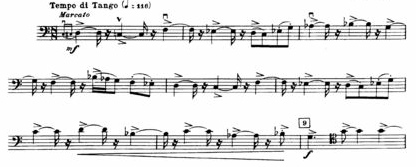Le Grand Tango
Piazzolla’s “Le Grand Tango” was premiered in 1990, just two years before Piazzolla’s death and eight years after it had been composed. As such, we can consider it one of the best examples of the development his music took, from his beginnings as a bandoneón player to composer and founder of the tango nuevo. The piece is written for cello and piano, particularly with the Russian cellist Rostropovich in mind, who also performed the premiere (Mauriño 2001, 252-253). The gap between its composition and its premiere by Rostropovich is due to the fact that the cellist had never heard of the composer when he received the score and therefore did not look at it for several years (Azzi 2000, 228). This piece is also frequently performed with viola and piano (Azzi 2000, 273). Many of the “crimes” against tango that Piazzolla was infamous for are featured in this piece, making it a good example of the tango nuevo.
One of the most obvious changes Piazzolla made to the traditional tango was the use of non-traditional instruments. The usual instrumentation for a tango band is built upon a set group, including the piano, violin, bandoneón, and bass. Although the orquesta típica (typical orchestra) could actually be much large, these four instruments were the basic elements for performing the tango. The choice of the cello, then, as a solo instrument, is a fairly dramatic one. Certainly, when Piazzolla received more criticism for even more unorthodox instruments like the electric guitar. In fact, he sometimes received more than just criticism: changing the “rigid dance music’s format resulted in death threats, cab drivers refusing him rides and a fistfight with a … tango singer” (McElfresh, 2000).
Another one of the main departures Piazzolla took from the tango was to incorporate jazz and classical elements to the popular genre (McElfresh 2000). In the following musical example, taken from the last twenty-five seconds of the piece, the cello has a highly chromatic (and very technical!) line to play. The incorporation of such chromaticism and the expectation of such a high technique level clearly demonstrate that this is not an ordinary tango, but a composition that incorporates elements of the original.
Rhythmically, Piazzolla would often expand the usual 3+3+2 grouping found in the milonga and traditional tango. Right from the beginning, Piazzolla has written the piece in 8/8 and the first two measures are grouped 3+3+3+3+2+2 (See Figure 1). This pattern repeats itself three times before he changes it. The fourth time (measure seven), the group is as follows: 3+3+3+3+3+1; instead of the final 2+2 of the previous six measures, he changes it to 3+1.

Figure 1
Even though these rhythms Piazzolla were not a great departure from the norm, later on in the piece he includes more technical and more rhythmic sections. These are such that the piece is un-danceable and therefore squarely outside of the traditional tango realm. The following music example continues where Figure 1 leaves off, from measures nine through twenty.
Piazzolla did not change every aspect of the tango, however. The first three minutes and forty-five seconds of the piece mirror fairly accurately a traditional tango in terms of form. During these first four minutes (only slightly longer than a tango canción), the cello plays a rhythmic first section and then a melodious “B” theme (the following musical example is part of the “B” theme).
Then the duet turns to a third theme, again melodic but completely different from the preceding section. This section lasts for about five minutes, during which time a fourth theme is seamlessly melded into the third and then the third returns again. About nine minutes in, the cello beings another completely different section that is undoubtedly the most technically challenging of all the sections. The first musical example we looked at is taken from this section. Another look at this example reminds us again how Piazzolla used unorthodox rhythms and wrote technically demanding parts that make this piece quite different from a traditional tango:
All in all, the piece runs about ten minutes long, making it considerably longer than a traditional tango. For this reason and for all of the others mentioned above, Le Grand Tango is an example of the tango nuevo that Piazzolla created.